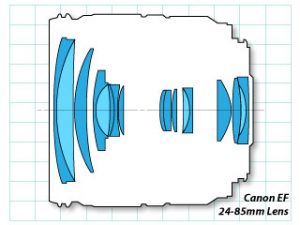 The lens is the eye of the camera. Light enters the lens, then travels through several individual glass components where it is refracted and redirected until ultimately it is projected onto the film or image sensor inside the camera to produce an image.
The lens is the eye of the camera. Light enters the lens, then travels through several individual glass components where it is refracted and redirected until ultimately it is projected onto the film or image sensor inside the camera to produce an image.
The primary definition of a “lens” is a transparent object used to bend light rays to converge on a surface. In a camera lens, multiple individual lenses (each called an element) combine to create a single unit that redirects the light to the image sensor (or film if you use a film camera).
Each element serves a specific purpose. Some reduce or enlarge, while some eliminate distortion introduced by other elements.
Lenses provide three very important features: Focus, Aperture, and Zoom.
Focus
When light reaches the camera lens, the rays arrive scattered and incoherent. Without a lens, there is no image, just a haze of light. The elements inside the lens help to redirect these light rays to a point where they reassemble the image on the film or image sensor. By adjusting the position of the elements, we can control what appears sharp and crisp and what is blurry. This is done by adjusting the focus ring.
 The focus ring has settings from near to far, allowing us to focus on subjects close to, or far away from the camera. Markings on the focus ring (if your lens is so equipped) show the focal distance. This is the distance from the front of the lens to the object that is in focus. Rotating the focus ring to the near settings bring objects near the lens into focus while larger distances put farther objects in focus. Most lenses have an infinity setting that means you are focusing at the farthest distance the lens will allow. This is great for distant mountains or far away buildings, but beware that many lenses can go slightly beyond the infinity setting by a small amount and put everything out of focus… very undesirable.
The focus ring has settings from near to far, allowing us to focus on subjects close to, or far away from the camera. Markings on the focus ring (if your lens is so equipped) show the focal distance. This is the distance from the front of the lens to the object that is in focus. Rotating the focus ring to the near settings bring objects near the lens into focus while larger distances put farther objects in focus. Most lenses have an infinity setting that means you are focusing at the farthest distance the lens will allow. This is great for distant mountains or far away buildings, but beware that many lenses can go slightly beyond the infinity setting by a small amount and put everything out of focus… very undesirable.
One caveat to some lenses is a focus ring that does not have locking end points. This means that the focus ring can rotate past the end of the focus adjustment. While the actual focus does not go beyond the lens’ limits, the ring no longer matches up with the same focus settings as it once did. If you use a follow focus, know that your markings can become useless if you over rotate your focus ring.
While most lenses let you focus out to infinity, many lenses have a difficult time focusing extremely close. Special lenses that allow for extremely close shots are Macro lenses and often cannot focus beyond a few feet. They do, however, provide excellent extreme close-ups.
Zoom
Zoom controls the focal length of the lens. The focal length refers to the distance between the lens and the point and where the image is focused (hopefully on the image sensor). Zooming in, also called Telephoto, increases the focal length. This makes the subject appear larger. Zooming out, or Wide Angle, decreases the focal length, resulting in the subject appearing farther away.
By moving the lens elements inside the main lens body, the light from a smaller area in front of the camera can be expanded across the image sensor which makes the subject look bigger and closer. Conversely, the elements can be arranged to allow a wider view to be projected on the sensor which makes the subject appear farther away.
Focal length is a number that is calculated based on the distance of the lens from the film or image sensor. But it is also affected by the size of the sensor. A larger sensor would capture more image and thus result in a smaller subject, while a smaller sensor would capture less of the image coming through the lens resulting in a larger subject. Therefore, focal length is less a measurement of the physical properties of the lens and more the appearance of the resulting image.
 We measure lenses based on their focal length. Normal focal length is 40mm. This captures an image comparable to that of the human eye. Telephoto lenses come in larger sizes, 75mm for example, and make your subject look bigger. Wide angle lenses capture a wider area, making your subject look smaller and farther away. These lenses are less than 40mm, i.e. 28mm. In the photo, a lens zoom ring is labeled with its minimum and maximum focal lengths: 30mm-200mm.
We measure lenses based on their focal length. Normal focal length is 40mm. This captures an image comparable to that of the human eye. Telephoto lenses come in larger sizes, 75mm for example, and make your subject look bigger. Wide angle lenses capture a wider area, making your subject look smaller and farther away. These lenses are less than 40mm, i.e. 28mm. In the photo, a lens zoom ring is labeled with its minimum and maximum focal lengths: 30mm-200mm.
Some lenses don’t offer zoom control. We call these Prime Lenses because their focal length is permanently set. These types of lenses are desirable because they offer a wider aperture than a lens equipped with zoom. Because of the mechanics of zoom lenses, they often limit the aperture size and even change the aperture size over the range of the zoom.
The Aperture
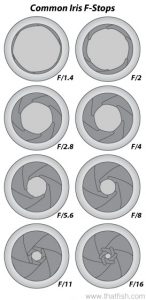 The aperture is a device inside the lens of the camera that controls the amount of light passing through toward the film or image sensor. The aperture (also called the iris) can be enlarged or reduced just like the pupil of a human eye, which performs the exact same function.
The aperture is a device inside the lens of the camera that controls the amount of light passing through toward the film or image sensor. The aperture (also called the iris) can be enlarged or reduced just like the pupil of a human eye, which performs the exact same function.
When there is too much light, our eyes close the iris to limit the amount that comes in. In darker environments, the iris opens to allow as much light as possible so you can see. The aperture works the same way.
If too much light enters the camera, the resulting images get overexposed (also called “blown out”), with definition in the bright areas completely lost. In the other extreme, if too little light makes it to the sensor, the image will be dark with definition in the darker areas unrecoverable as well. When the proper amount of light is allowed to enter, the image is rich and adequately detailed.
While there is a little latitude during the post production process, it is extremely beneficial to make sure you have proper exposure when you shoot.
While some experienced camera operators can estimate light levels simply by looking, most of us are not that knowledgeable. Thankfully, several tools exist to help determine the proper f-stop setting for your shot. Light meters have been popular for decades. More typically, with modern cameras, you can get very good settings by using the automated features on the camera to get a starting point. (Remember, NEVER use anything automatic on a camera for your actual shot… it’s not professional… well, at least don’t use it in front of professionals 🙂
Remember, in dark conditions, open up the aperture. In bright conditions close it up. But…
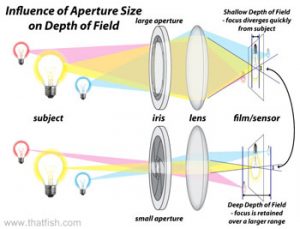 Closing the iris has a downside. A smaller aperture limits the paths of the light rays entering the camera. This expands the amount of your scene that is in focus. The space in your scene that is in focus is called Depth-Of-Field. The diagram demonstrates this. (click on the image for a high-res version)
Closing the iris has a downside. A smaller aperture limits the paths of the light rays entering the camera. This expands the amount of your scene that is in focus. The space in your scene that is in focus is called Depth-Of-Field. The diagram demonstrates this. (click on the image for a high-res version)
A deep depth-of-field means that a large range of space inside your shot is in focus. A shallow depth-of-field results in a very narrow band of your image being in focus. In these photos you’ll see the difference between a low f-stop exposure (wide aperture) and one of a high f-stop setting. The rocking horse in the back ground shows the big difference in blurring as both shots were focused on the same wood railing post.
Having a deep depth of field greatly reduces the visual appeal of the resulting image. This is a common issue with shooting video with a video camera as their smaller chip size and limited iris settings prevent achieving a shallow depth-of-field.
 If all you have is a video camera with a lens that is not removable, you may want to look into depth-of-field adapters. They allow you to add a separate lens to your camera, which increases the focal length and gives you the freedom you need to control your focus.
If all you have is a video camera with a lens that is not removable, you may want to look into depth-of-field adapters. They allow you to add a separate lens to your camera, which increases the focal length and gives you the freedom you need to control your focus.
Lens Markings
Lenses come marked with focal length and aperture settings somewhere on their bodies. This information helps you understand its zoom and aperture capabilities.
Focal Length
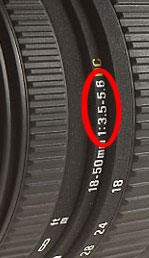 The focal length of a lens is typically the first number listed on its face or side. In this example, the camera’s focal length is 18-50mm. This means that it is a zoom lens that can zoom from 18mm to 50mm.
The focal length of a lens is typically the first number listed on its face or side. In this example, the camera’s focal length is 18-50mm. This means that it is a zoom lens that can zoom from 18mm to 50mm.
Aperture Size
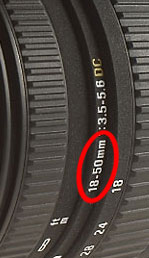 The aperture size follows the focal length and is displayed in the format of 1: wide-angle maximum aperture-telephoto maximum aperture. The wide-angle maximum aperture is the widest aperture you will get when zoomed all the way out. The telephoto maximum aperture is the widest aperture the lens can offer when zoomed all the way in. In the example the lens is 1:3.5-5.6, where the maximum aperture when zoomed out to 18mm will be an f-stop 3.5, and the maximum aperture when zoomed in to 50mm will be an f-stop 5.6.
The aperture size follows the focal length and is displayed in the format of 1: wide-angle maximum aperture-telephoto maximum aperture. The wide-angle maximum aperture is the widest aperture you will get when zoomed all the way out. The telephoto maximum aperture is the widest aperture the lens can offer when zoomed all the way in. In the example the lens is 1:3.5-5.6, where the maximum aperture when zoomed out to 18mm will be an f-stop 3.5, and the maximum aperture when zoomed in to 50mm will be an f-stop 5.6.
While reducing aperture size has a negative effect on depth-of-field, some of that is made up when zooming in as this increases the focal length, which helps increase depth-of-field.
Lens Speed
Aperture size and shutter speed are interrelated. Increasing one requires you to decrease the other and vice-versa. Prime lenses do not have zoom mechanisms and can thus achieve much larger apertures.
While a common zoom lens will have an aperture range of 3.5 to 5.6, a prime lens can be as low as 1.4, or even 1.2. This increased size means that the shutter speed must be decreased to balance out the exposure. Reducing the shutter speed means the image is taken more quickly, or faster. Therefore, a lens with a wide aperture is considered a “Fast Lens“. Lenses with smaller aperture require a longer shutter speed and are “slower”.
Faster lenses provide shallower depth-of-field because of the increased aperture, making them desirable for film production. Remember that you’ll likely need a Neutral Density filter to maintain your 1/40th or 1/50thshutter because of the extra light that is getting through your lens.
Conclusion
The lens is a critical tool in the filmmaker’s arsenal. Once you understand the basic components and functions of a lens you can use it to improve your work and become a better artisan. When your work looks more professional your audience will spend less time picking over your production values, and more time being absorbed into your message.
God bless your Christian films!